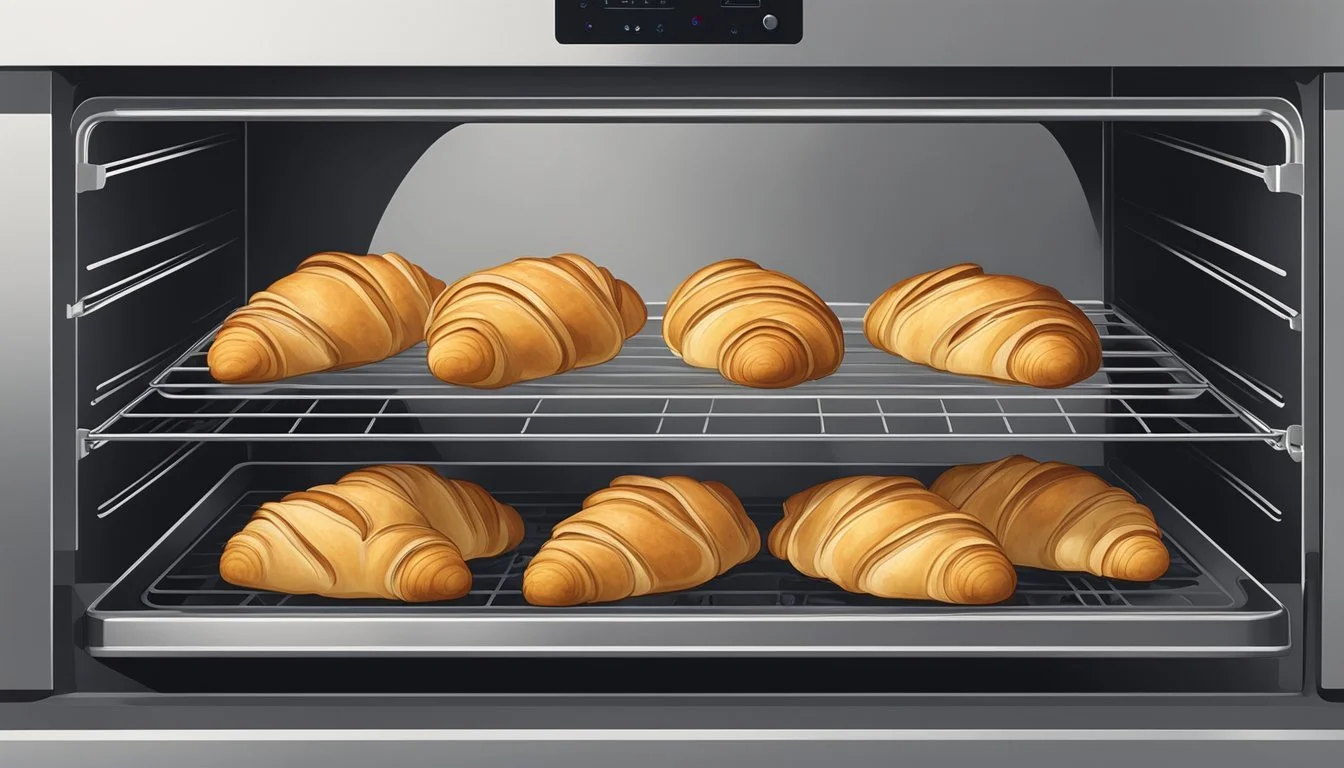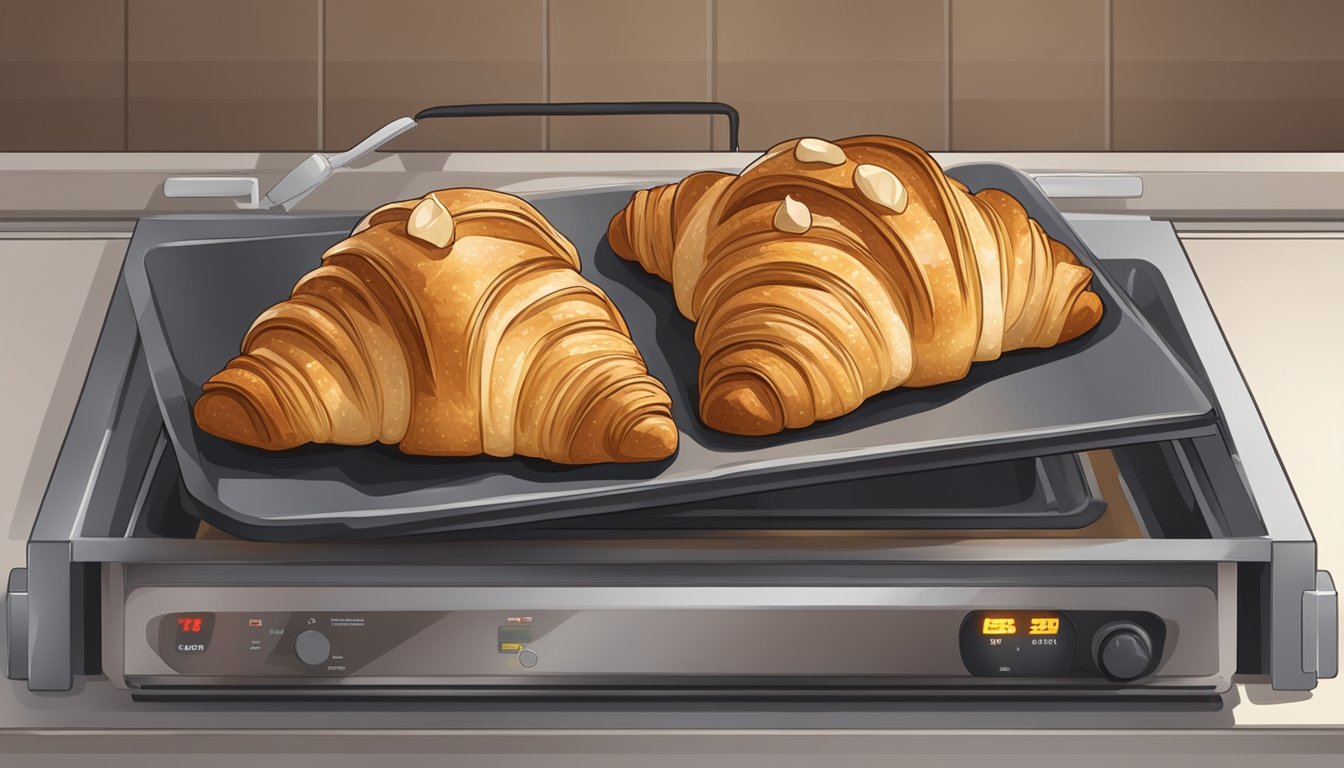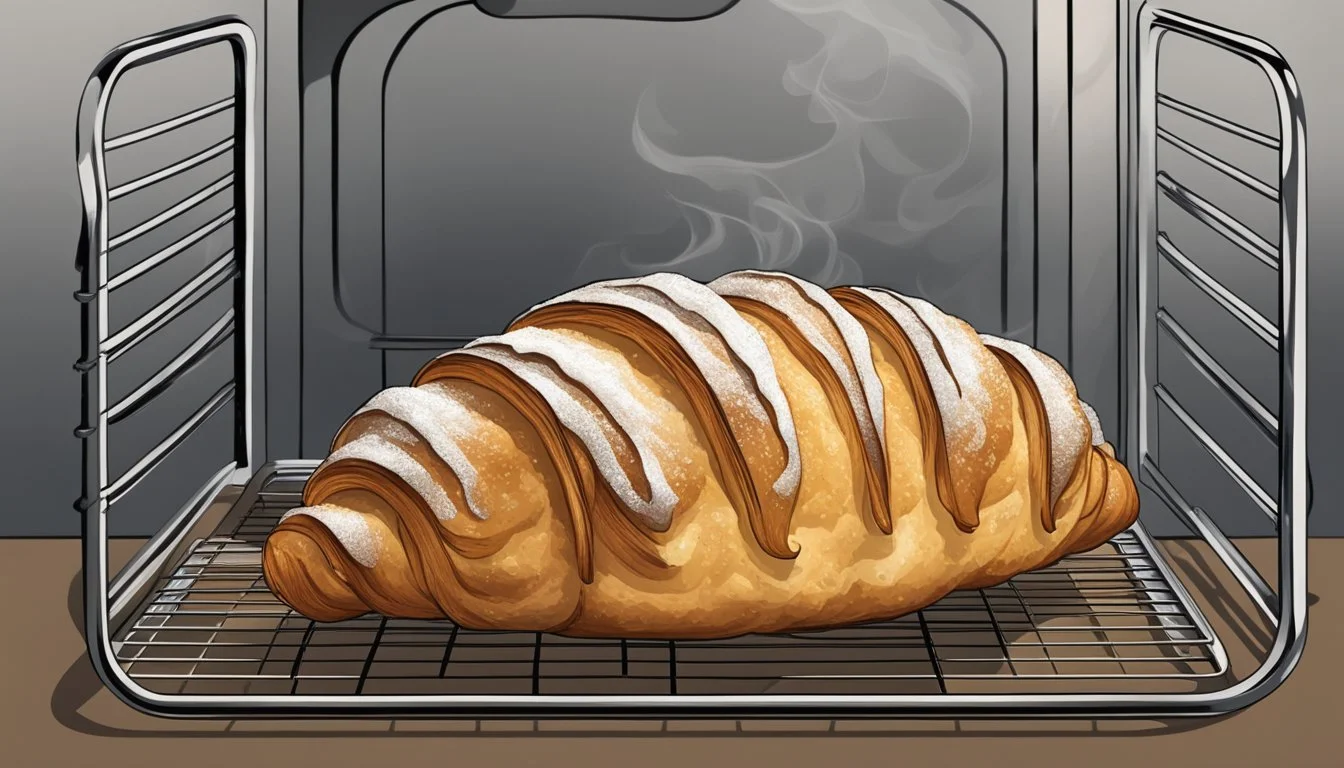Best Way to Reheat Almond Croissant
Tips for Preserving Flakiness
An almond croissant, with its flaky layers and rich almond filling, is a delightful pastry that many often enjoy as a luxurious treat. Ensuring that a leftover or stored croissant retains this quality upon reheating is a concern for pastry enthusiasts. Reheating an almond croissant properly can make the difference between preserving its delicate flakiness or ending up with a pastry that's soggy or overly dry.
To achieve the best results, a moderate oven temperature and careful preparation are key. The process begins with preheating the oven, which allows for an even distribution of heat. It's essential to wrap the croissant properly, which helps to maintain moisture without causing the pastry to become soggy. The correct reheating technique will not only warm the croissant but also revitalize its texture, bringing back the buttery softness and flaky crust as if it were freshly baked.
Moreover, for those who prefer quicker methods, an air fryer serves as an efficient alternative to the traditional oven. With its rapid air circulation, an air fryer can provide an evenly heated environment that restores the croissant's desired texture in just a few minutes. Properly utilizing these methods ensures the almond croissant is adequately reheated, offering a nearly fresh-from-the-bakery experience with each bite.
Understanding the Croissant's Structure
The almond croissant's indulgent appeal lies in its distinctive structure, which marries flaky texture with rich flavor. Here's how these characteristics come into play.
Flaky Texture and Laminating Process
The signature flakiness of a croissant is attributed to the meticulous process of laminating. During this process, dough is repeatedly folded and rolled with layers of butter, creating hundreds of paper-thin layers. As the croissant bakes, steam released from the melting butter puffs up these layers, resulting in a light, airy structure.
Key Steps of Laminating:
Dough Preparation: A simple, yeasted dough is made.
Butter Incorporation: Cold butter is carefully folded into the dough.
Folding and Rolling: The dough is folded and rolled multiple times.
Resting: Between each fold-and-roll, the dough must rest to relax gluten and firm up the butter.
Final Roll: The dough is rolled out to a specific thickness before shaping.
Factors Affecting Freshness and Flakiness
Several factors play a pivotal role in maintaining the croissant's freshness and its delicately flaky texture:
Temperature: Excessive heat can melt the butter prematurely, while insufficient heat won't allow the layers to expand properly.
Humidity: Too much moisture can make the dough soggy and collapse the layers.
Storage: Airtight storage keeps the croissant from drying, but can also soften its crisp exterior.
Time: Freshness diminishes over time, affecting both taste and texture.
By understanding these elements, one can better approach the reheating of an almond croissant in a way that best preserves its flaky texture and delectable flavor.
Preparation for Reheating
Proper preparation is crucial to restoring the delicate flakiness of an almond croissant when reheating. Correct thawing and handling methods contribute to an optimal eating experience.
Thawing Frozen Croissants
To ensure the best results when reheating frozen almond croissants, one should initially thaw them gently. Place the croissants in the refrigerator overnight, allowing for a slow and even thaw without compromising their structure. Should an expedited method be necessary, they can be left at room temperature for approximately an hour before reheating.
Refrigerator Thawing: 12 hours in the fridge (optimal)
Room Temperature Thawing: 1 hour
Handling Stale Croissants
Stale croissants require special attention to return to their former glory. When dealing with stale almond croissants, one should slightly moisten them by brushing the surface with a dab of water before placing in the oven. This reintroduces moisture, reviving the flaky and tender texture.
Surface Moistening: Lightly brushing with water
Reheating Techniques
Proper reheating can restore the freshness and flakiness of an almond croissant, making it nearly as delightful as when it first came out of the bakery oven. Different methods can be employed based on the tools available and personal preference, each with specific steps to ensure optimal results.
Oven Reheating Method
The oven is often the preferred method for reheating croissants as it evenly circulates heat and can recreate the bakery-fresh texture. For almond croissants:
Preheat the oven to 350°F (175°C).
Place the croissant on a baking sheet.
Reheat for 2-3 minutes if at room temperature, or about 7 minutes for frozen.
Toaster Oven and Air Fryer Techniques
Toaster ovens and air fryers offer a quick and convenient alternative:
Toaster Oven: Set it to 300°F and heat for 3-5 minutes.
Air Fryer: Preheat to 300°F; for leftovers, heat for 3-4 minutes, and for frozen, 7-8 minutes.
Stovetop Frying Pan Method
The frying pan method provides a crispy exterior without the need for an oven:
Preheat a non-stick pan on medium heat.
Place the croissant in the pan and cover it with a lid.
Warm for 1-2 minutes per side, monitoring closely.
Microwave Method with Caution
Microwaves should be used with caution as they can easily make croissants chewy:
Heat in short 10-15 second bursts, checking between intervals to not overdo it.
Optimizing Reheating Results
To achieve the perfect reheating of an almond croissant, one must manage moisture and crispness, while carefully controlling the reheating time and oven temperature.
Using Foil, Paper Towel, or Water
One can utilize foil to wrap the croissant, which helps in maintaining its moisture during the reheating process. In contrast, using a paper towel can absorb excess moisture, helping to keep the croissant more crispy. A small amount of water sprinkled over the croissant or a paper towel can also provide just enough steam to prevent drying out.
Foil: Encase the croissant to retain moisture.
Paper Towel: Wrap the croissant to absorb excess moisture and aid in even heating.
Water: Lightly sprinkle to create steam.
Monitoring Time and Temperature
Observing the proper time and temperature is crucial to avoid overcooking. A preheated oven at 350°F (175°C) is recommended for a balance of warmth and texture. Place the almond croissant on a baking sheet, then heat it for a short duration.
Temperature: 350°F (175°C)
Time:
Fresh croissant: 2-3 minutes
Frozen croissant: 7 minutes
Note: Consistently monitor the croissant to prevent burning. Each croissant may vary slightly in size and density, potentially altering the required heating time.
Safeguarding Croissant Quality
Maintaining the delicate flakiness and rich, buttery flavor of leftover croissants requires proper storage and reheating techniques. The following subsections outline specific methods for preserving the quality of these pastries.
Storing Leftover Croissants Correctly
Leftover croissants should be stored in a way that retains their freshness and texture. To properly store croissants:
Keep them at room temperature: Croissants are best kept in a cool, dry place for up to 2 days.
Use airtight containers or bags: Seal them in an airtight container or plastic bag to prevent exposure to air.
Best Practices for Reheating Chocolate Croissants
The goal of reheating chocolate croissants is to revive the crispness without melting the chocolate excessively. When reheating:
Preheat your oven to 350°F (175°C): This temperature helps to warm the croissant evenly.
Heat for a short duration: Place the chocolate croissant on a baking sheet and heat for 3-4 minutes if fresh, or around 7 minutes if from frozen.
By adhering to these storage and reheating methods, one can enjoy a chocolate croissant that closely resembles its original state, with a flaky exterior, and a warm, soft interior where the chocolate remains indulgent but not overly melted.
Creative Alternatives to Reheating
When a traditional reheat doesn't suffice, one can explore various creative ways to repurpose a croissant, giving it new life and flavor.
Making a Croissant Toastie
A croissant toastie can be a delightful way to rejuvenate a day-old croissant. One simply stuffs the croissant with their preferred fillings—be it cheese, ham, or a vegetarian option—then presses it in a panini press or a hot skillet until the exterior turns golden and crisp, while the inside becomes deliciously melted.
Ingredients:
1 almond croissant
Fillings of choice (e.g., cheese, ham, vegetables)
Instructions:
Slice the croissant in half but not all the way through to create a pocket.
Insert the desired fillings.
Heat a panini press or skillet, and cook the stuffed croissant until the outside is crisped to satisfaction.
Transforming Into Bread Pudding
Transforming a croissant into bread pudding offers a dessert or breakfast option that is both scrumptious and innovative. Tear the croissant into bite-sized pieces and soak them in a rich custard base, then bake until set. This method does not just revive the pastry but infuses it with moisture and flavor.
Ingredients for Custard Base:
Eggs
Milk or cream
Sugar
Vanilla extract
Instructions:
Preheat the oven to 350°F (175°C).
Whisk together the custard ingredients.
Pour over the torn croissant pieces in a baking dish and let soak for 10 minutes.
Bake for 25-30 minutes or until the pudding is set and the top is golden.
Croissant French Toast Recipe
Making croissant French toast is a simple yet sublime twist on classic French toast. Slice the croissant in half and dip it into a mixture of egg, milk, and a touch of cinnamon, then cook on a skillet until each side is perfectly browned. Serve with a dusting of powdered sugar and fresh fruits or syrups for an indulgent treat.
Ingredients for French Toast Mix:
1 egg
1/4 cup of milk
1/2 teaspoon of cinnamon
Instructions:
Beat together the egg, milk, and cinnamon.
Soak each half of the croissant in the mixture, being careful not to oversaturate.
Cook on a preheated skillet over medium heat until both sides are golden.
Serve with a sprinkle of powdered sugar and toppings of choice.
Additional Tips and Common Mistakes
Reheating almond croissants properly can enhance their flakiness and maintain a fluffy texture, but several key factors must be considered to avoid common mistakes.
Ensuring a Fluffy and Non-Soggy Outcome
To ensure croissants remain fluffy rather than becoming soggy, one should preheat the oven before placing the leftover croissant inside. Moreover, wrapping the almond croissant in foil helps to keep the moisture evenly distributed while reheating. It's advisable to remove the foil in the last couple of minutes of reheating for that perfect crust.
Avoiding Over-Reheating and Burning
The ideal temperature for reheating almond croissants is between 300°F to 350°F (150°C to 175°C) with distinct times for different reheating methods.
An oven requires 7-10 minutes for a standard appliance or 5-7 minutes in a convection oven.
A toaster oven is faster, needing only 3-5 minutes.
Monitoring the croissant closely prevents both over-reheating and burning, key to achieving the desired flakiness of the crust without drying it out.
Conclusion
When it comes to reheating almond croissants, the key is to maintain the delicate balance between a crispy exterior and a soft, moist interior. The most effective methods include using a conventional oven or toaster oven, an air fryer, and, as a last resort, a microwave.
Oven or Toaster Oven: Preheat to 350°F (175°C) for a regular croissant or 300°F (150°C) for an almond croissant. Warm it for approximately 7-10 minutes. If the croissant is frozen, extend the heating time accordingly. Covering it loosely with foil can prevent excessive browning.
Air Fryer Reheating: Set to 300°F and heat a regular croissant for 3-4 minutes; for a frozen one, allow 7-8 minutes. The air fryer is adept at restoring flakiness without sapping moisture.
Microwave Reheating: Although not ideal due to the risk of sogginess, microwaving on a low setting for short 10-15 second bursts can work in a pinch.
It is advisable to avoid reheating a croissant multiple times as it may become dry and lose its flakiness. Regardless of the method chosen, the outcome should resemble the fresh quality of a Vienna croissant — a term often synonymous with high-quality, flaky croissants. To ensure optimal results, one should allow the croissant to come to room temperature before reheating, especially if it has been stored in the refrigerator.
By following these methods, the integrity of the almond croissant's texture and flavor can be preserved, closely emulating the experience of enjoying it freshly baked.






